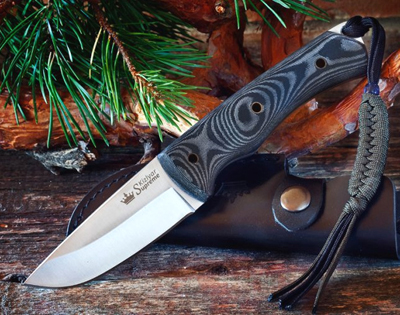Choosing a knife for tourism, hunting and fishing
We independently test the products and technologies that we recommend.

When choosing a knife, you need to decide how you plan to use it. After all, the intended use will maximize the potential of the model and extend the life of the knife.
Folding or with a fixed handle?
One of the first questions that arises when choosing is to take a folding knife or with fixed handle? Folding knives are more compact and lightweight, and thus more comfortable to wear. They are suitable for simple household purposes, such as cutting and cleaning food, opening bottles, stripping wires - in general, a universal accessory for a city dweller. Although there are folding models for "extreme" use. In turn, non-folding models are more reliable, durable and easy to use. Therefore, they are much better suited for tourists, hunters and fishermen. Although, of course, you can successfully use such a knife in the kitchen.
When choosing a folding knife, it is usually recommended to take into account the peculiarity of the mechanism that locks the blade. The convenience with which the knife opens and folds and the reliability of fixing the blade depends on it. However, if you are a beginner, it will not be easy to understand the differences. Knife manufacturers use many solutions (Liner-Lock, Back-Lock, Axis-Lock, etc.). When choosing the first knife, you should not delve into such subtleties. All the same, the difference between them can be felt when you independently compare knives with different designs. Note that the Liner Lock mechanism is very popular - this is a good choice for those who have not yet become a knife specialist. Liner Lock has a simple design with a minimum of parts and therefore is one of the most reliable locks.
Blade characteristics: length, construction and steel
An important selection criterion is the length of the blade. The principle “the longer the better” does not work in this case. The long massive blade looks beautiful and convincing, but at the same time significantly increases the weight of the knife and makes it uncomfortable to wear. And when walking with such a “tool” around the city, you risk arousing interest from law enforcement officers. For a universal everyday knife, a blade length of about 7-9 cm is quite enough. But for hunters and fishermen, as well as lovers of extreme outings into nature, it is worth choosing larger specimens - with a blade of 12-15 cm (example - OPINEL 12 VRI).
The blades also differ in the type of cutting edge. In addition to the traditional smooth, there is also sharpening with teeth - the so-called serrated. It has the best cutting properties and retains them much longer. On the other hand, a serrated blade requires more effort from the owner when using such a knife and additional devices when sharpening it. Such a blade is well suited for some specific tasks, such as cutting through dense fibrous materials. In addition, the serrated edge works well when you need to cut soft or brittle foods. However, pure serrated blades are rarely used. But they can often be found in folding knives as auxiliary tools. In addition, there are quite a few knives with a combination blade (for example, Gerber Folding Sheath Knife). This makes the model universal, but has a significant drawback - the area of the main (smooth) cutting edge is reduced.
 |
| Gerber Mini Covert Combination Blade Knife |
It is also necessary to carefully consider the choice of steel (or rather, its brand), from which the blade is made. Steel with a high carbon content (like common grades of group 440) is harder. Due to this, the hard steel blade has the best cutting properties and remains sharp for a long time. True, she also has disadvantages - she is more susceptible to corrosion and has high fragility. When colliding with a harder material, such steel may begin to crumble. Softer blades made of stainless steel (such as AUS-8) dull more quickly, but still sharpen quite easily.
The nuances of choosing a handle
The handle of a knife is no less important than the blade - this applies to both shape and and the material from which it is made. For maximum grip comfort, the length of the handle should slightly exceed the width of the palm. If possible, it is better to avoid sharp-angled handles, as they reduce comfort when holding. The same applies to overly saturated relief - it's beautiful, but not convenient for long-term work with a knife. On the other hand, round handles can be rotated in the hand.
Many consider wood to be the optimal material for the handle, and for good reason - it is pleasant to the touch and has an aesthetic appearance. However, it also absorbs moisture and dirt. At the same time, plastic is undeservedly underestimated - modern compositions are not inferior to wood in terms of reliability, but at the same time they are easier to clean. There are also models with metal handles, which have increased strength, but they are not very suitable for working in cold or hot weather. Metal is sensitive to temperatures and it is not convenient to hold a cold or hot knife in your hand. There are also knives with fiberglass handles — Leatherman Style PS, Ganzo G712 and others. They have strength, light weight, moisture resistance and low thermal conductivity (they do not heat up and cool down). The main disadvantage of knives with fiberglass handles is the relatively high cost.
Types of knives by purpose
| Signal is Leatherman's 19-Tool Multi-Tool for various tasks |
It is also important to understand the division of knives into types depending on their purpose and scope.
Quite popular Swiss knives, designed for use in the army as a universal working tool. As practice has shown, they are also the best solution for everyday use due to their extensive functionality. After all, even budget "Swiss" in addition to the main blade have a few more additional devices like a corkscrew or opener. However, all Swiss knives are folding and quite compact when folded.
More expensive multitools usually have more accessories, including such , which are rarely found in ordinary knives, such as scissors. Significant differences in the design of the "Swiss" and multi-tools allow you to fit in the last 15-20 different devices (and sometimes more). Inexpensive models, as a rule, have a standard set of accessories for domestic use, such as an opener, a can opener, pliers, various screwdrivers, etc. And advanced items may include quite serious tools for repair, electrical and other specialized work. In addition, there are models with elements that will be useful for outdoor enthusiasts - various kinds of camping equipment, as well as tools for fishermen and hunters.
One of the most common and versatile types is the so-called camping knives. They are both folding and awkward (the first - more). As a rule, such knives have a number of additional features that are useful to tourists, but very rarely include elements that are necessary to perform any specialized tasks. Such models differ in blade size and cutting edge type, so the choice should be made based on the tasks for which the knife is purchased.
 |
| Kizlyar Supreme KiD 440C Satin — hunting knife with genuine leather sheath (with belt loop) and lanyard |
Among specialized models, fishing and hunting knives. Both are fixed-blade designs, although folding versions are rare. These models are "sharpened" for various outdoor tasks related to setting up a camp, butchering carcasses, skinning, cleaning fish, etc. The design of these models provides maximum reliability and often has various features to improve grip and fixation of the knife, such as sub-finger recesses, lanyard mounts, etc. Not all novice fishermen and hunters know that a special case is needed to carry a knife. Don't repeat their mistakes and select model with case Machete. Their feature is the large size of the blade, often exceeding 20 cm. Accordingly, it is used for a narrow range of tasks that are closer to axes than to knives. Their help is resorted to when cleaning the area from shrubs and small trees, as well as cutting paths in difficult places in the forest. Also, the machete can be used when chopping small firewood and brushwood. But it is not convenient to use such models in a different way because of their large weight and dimensions. Machetes are the choice of experienced hikers, hunters, and others.
Another interesting type is butterfly knife or balisong. Its peculiarity is the original way of unfolding - when opening the halves of the handle, they rotate 180 degrees in opposite directions relative to the blade, exposing it and, connecting, form a handle. For this, the knife got its name.
According to one version, such knives were invented by Filipino fishermen for greater ease of use in the process of fishing, since it can be easily opened with one hand. Like it or not, but its use for fishing is unlikely to be more effective than specialized knives, so it is more advisable to use it for cutting food. In addition, there are many tricks using a butterfly, which is why such knives are popular with young people.
Summary
It is unlikely that on the basis of advice you will be able to choose a knife that will suit you absolutely in all aspects. After all, only personal experience of using at least a couple of models will allow you to finally figure out what exactly you need. However, these tips will make it easier to find the right solution and avoid purchasing a tool that will ultimately disappoint your expectations.
Come back from vacation and show your friends how you had a great time (by filming your adventures ).
How the most popular waterproof and shock-resistant watches are made.
Five good flashlights that can help both outside the city and within it.
USB drives that keep your important information safe.
Are you afraid to take your expensive smartphone on a hike or to the sea? Maybe it's time to buy a secure smartphone?
Articles, reviews, useful tips
All materials














